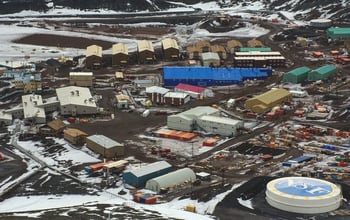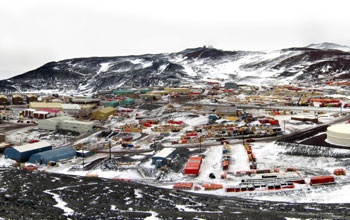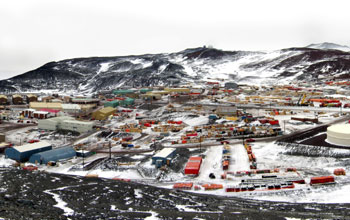Extreme Construction: Building in Antarctica
There’s a rare opportunity to work on a construction project located at the bottom of the world in a location few have ever visited. McMurdo Station, the largest of three U.S. Antarctic research stations, is about to undergo a massive construction and consolidation project over the next several years.
McMurdo Station, located on the Hut Point Peninsula of Ross Island, began life as a temporary naval base in 1955. Naval Air Facility McMurdo was established to serve as a logistics base to support construction of a research facility at the South Pole during the International Geophysical Year of 1957-1958. The National Science Foundation’s U.S. Antarctic Program (USAP) took over the station in 1961 and it has been used as a research and logistics station ever since.
Despite being designed as a temporary base, McMurdo Station has grown to encompass over 100 buildings on its 164-acre campus. The current station is outdated and a blue-ribbon panel conducted in 2012 determined that most of the buildings need to either be repaired or replaced to meet the needs of the scientific research and improve the logistics infrastructure.
The Antarctic Infrastructure Modernization for Science (AIMS) project will improve logistics around the station, address energy efficiency of the station, decrease energy demand, reduce operations and maintenance costs, and promote environmental stewardship. The AIMS project will consolidate the number of buildings and greatly reduce the footprint of McMurdo Station.
The AIMS project will consolidate the 100+ buildings that comprise McMurdo Station down to 16, including 10 existing buildings and the construction of 6 new buildings. The first building planned for construction as part of the AIMS project is the Information Technology & Communications building as well as relocating and extending utility lines running from the building to other parts of the station.
Life at McMurdo Station
Life at McMurdo Station is like living in a small town located in the middle of nowhere. The station has about 1,200 residents during the summer months, made up of research scientists and support personnel to keep the station running, cook meals, run the fire station, clean, provide transportation, perform maintenance, IT support, etc. During the winter months, the population drops to about 250 residents.
Residents live in double-occupancy dormitories and all staff members are provided with three free meals a day. The station features a number of amenities including a post office, library, laundry facilities, gyms, a store, hair salon, 24-hour coffee house, movie lounges, music room and instrument rentals, a disc golf course, and two bars, Gallagher’s and Southern Exposure.
There are also plenty of activities available to participate in during downtime. There are a number of indoor and outdoor activities for residents of McMurdo Station. From hiking and cross-country skiing to yoga and basketball, there’s something for everyone. Many of the residents offer classes and talks on a wide range of topics.
 McMurdo Station
McMurdo Station
Construction Challenges in Antarctica
Construction in such a remote and harsh environment like Antarctica presents its own unique sets of challenges and rewards. For starters, you have to have all of your materials, equipment, building supplies, tools, office equipment, etc. packed and shipped on the annual supply ship to McMurdo. There’s no running out to replace broken tools or pick up additional materials if you didn’t order enough to begin with.
All prefabrication work must be completed and supplies need to be ordered with enough lead time to make the shipping deadline. Prefabrication will help reduce the amount of time workers have to spend outside in the elements and reduce the overall construction timeline in Antarctica.
All equipment, materials, and supplies must be thoroughly cleaned prior to shipping to remove all dirt, debris, mold, dust, etc. to avoid accidentally introducing non-native species of plants or animals to Antarctica. This requires an extra level of planning and coordinating that goes above your typical construction project.
Weather
The weather is another major concern. Antarctica is the driest, coldest, windiest continent. The average annual mean temperature at McMurdo Station is 0° F. Even in the summer months, the average high temperature doesn’t get above freezing although highs of 50° F or more have been recorded in November, December, and January. In addition to the cold, Antarctica is also a desert so it’s important that workers remain hydrated when working.
Working outside in extreme cold temperatures can be dangerous if you don’t take the necessary precautions to keep your body warm and dry on the construction site. Cold stress, hypothermia, and frostbite are real threats when doing construction in Antarctica. The USAP provide Extreme Cold Weather (ECW) gear to worker including a parka, boots, insulated Carhartt bib coveralls, fleece jacket, hat, gloves, neck gaiter, and goggles. Workers tend to move a bit slower, especially when bundled up in Extreme Cold Weather gear to stay warm.
Weather delays are also a possibility during every month in Antarctica. Reasons for weather delays include: crane use being stopped when winds exceed 22 knots (25mph), temperatures below -30° F will stop exterior work, as will snow accumulation of six inches per hour in light winds or four inches per hour in heavy winds.
 McMurdo Station
McMurdo Station
Site Conditions
The unique site conditions at McMurdo Station could also present some challenges. The station is built on bare volcanic rock and permafrost. Soil samples have to be taken and tested for contaminants in any area where excavation work is planned. If contaminants are found, a remediation plan has to be developed before excavation can begin. The new IT&C building is being constructed on precast concrete footing sitting on the surface and elevated off the ground to avoid heat from the buildings melting the permafrost below.
Productivity expectations should be lowered when working in extreme cold conditions. Excavation and earthwork of frozen ground take longer than in normal conditions because the ground is so much harder. Because of the volcanic rock, blasting may be needed as part of trenching and excavation work.
Because of the ongoing scientific research being conducted at McMurdo and across the continent, construction activity must be performed in a way as not to impede or interrupt any of the research activity being conducted around the station.
Environmental Stewardship
The Antarctic Treaty System places a high priority on protecting the environment of Antarctica. Because of this, there are a number of rules and regulations aimed at protecting and preserving the native Antarctic wildlife and habitats. Construction activity requires stringent environmental review and there are strict protocols and procedures governing excavation, the use of hazardous materials, environmental reporting, and waste management that go beyond the typical construction project.
